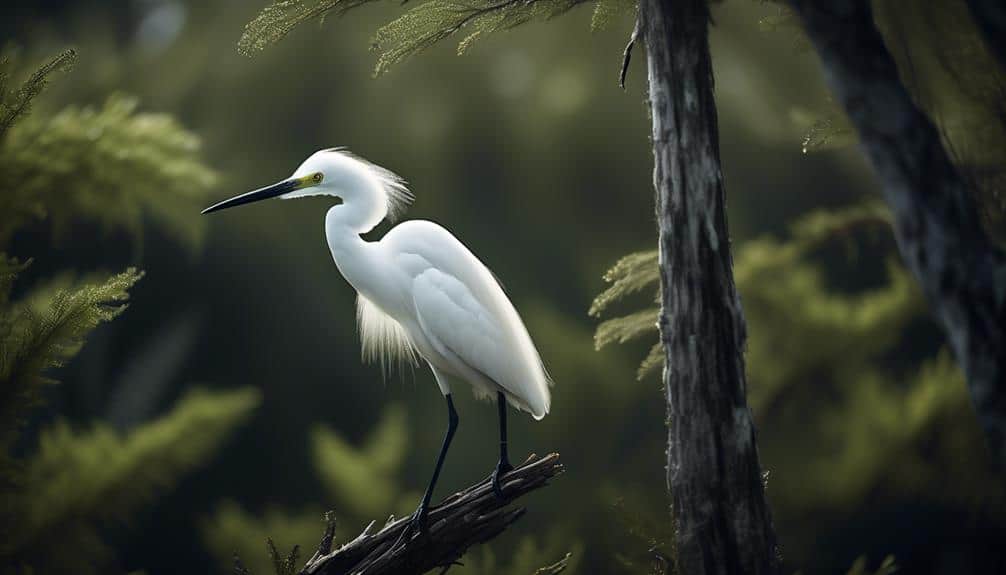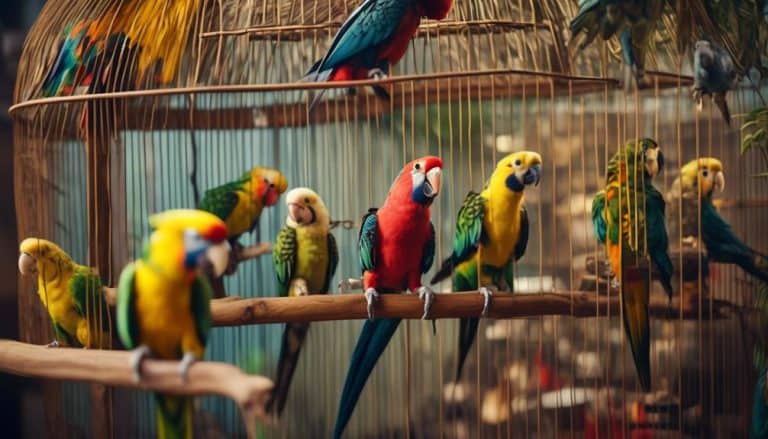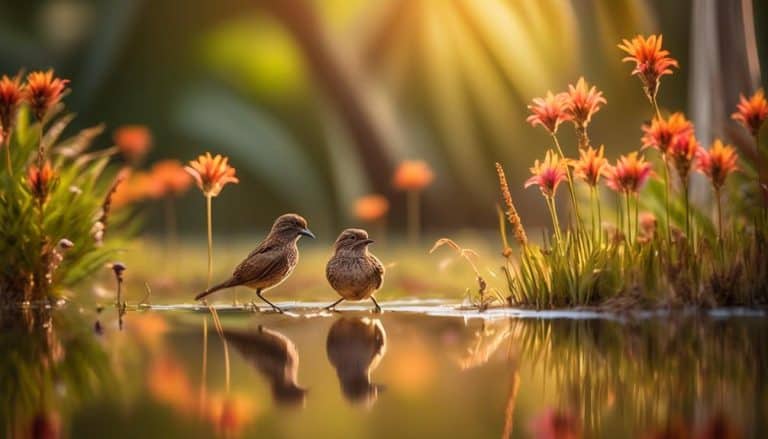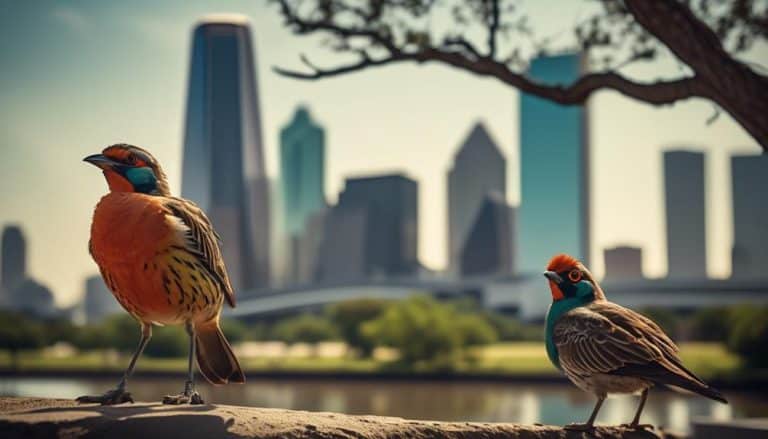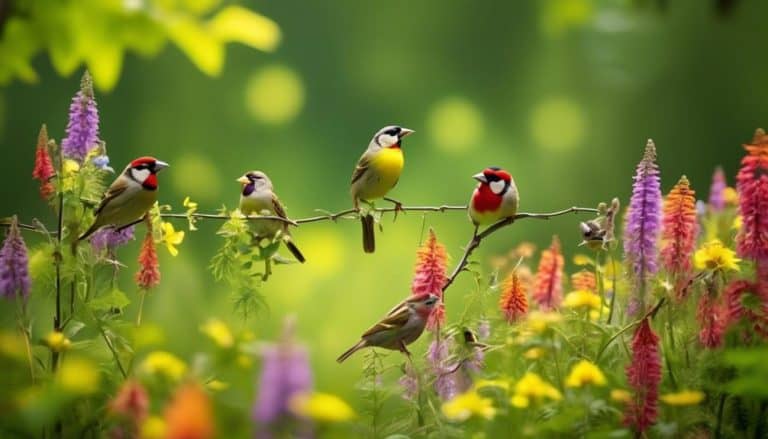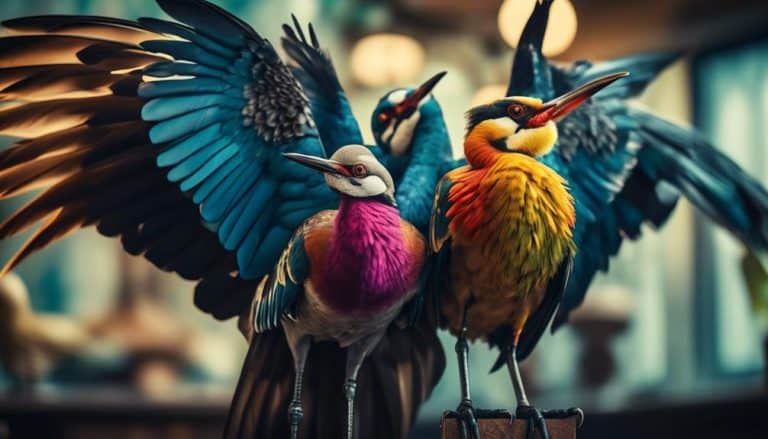As I stepped onto the sandy shores of Florida, my eyes were immediately drawn to the striking contrast of black and white birds that graced the landscape.
The avian inhabitants of this vibrant state are not only diverse in their colors and patterns but also in their behavior and habitats.
From the elegant Snowy Egret to the elusive Black-and-white Warbler, these feathered creatures captivate both bird enthusiasts and casual observers alike.
But what is it about these black and white birds that make them so intriguing?
Join me as we uncover the secrets of these captivating creatures and explore the fascinating world they inhabit.
American Oystercatcher
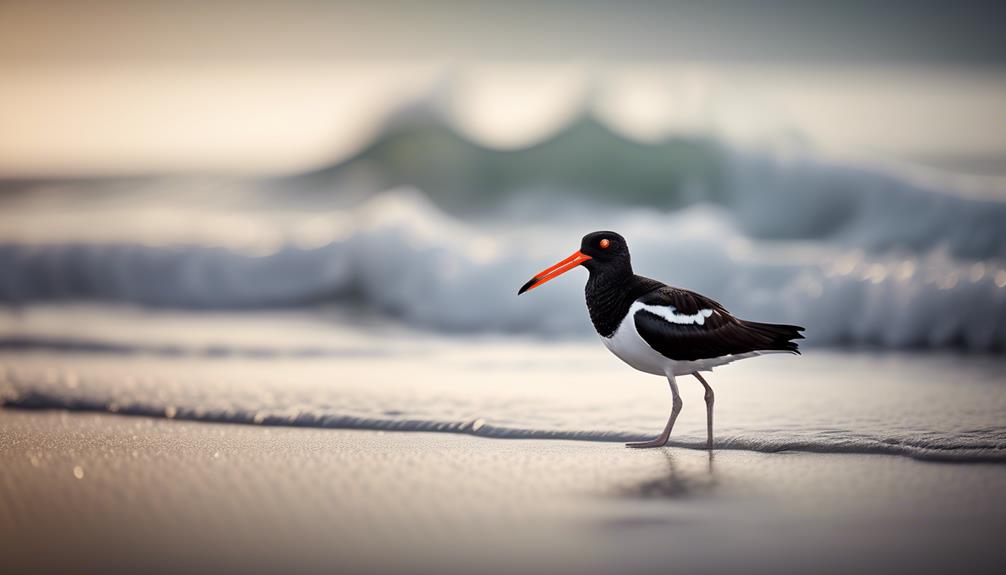
The American Oystercatcher is a striking black and white bird found along the coastlines of Florida. This species is a focal point of conservation efforts due to its declining population.
The habitat of the American Oystercatcher consists of sandy beaches, coastal dunes, and salt marshes. These birds are highly dependent on these habitats for nesting, foraging, and wintering. They prefer to nest in open areas with minimal vegetation and close proximity to the shoreline.
When it comes to behavior, the American Oystercatcher is known for its distinctive calls and territorial displays. They're monogamous and form long-term pair bonds. During the breeding season, they defend their nesting territories vigorously, displaying aggressive behaviors towards intruders.
The diet of these birds mainly consists of bivalves, such as clams and mussels, which they're well adapted to feed on due to their specialized bill. They use their long, thick bills to pry open the shells of their prey.
Conservation efforts for the American Oystercatcher focus on protecting their coastal habitats from human disturbances, such as beach development and recreational activities. Additionally, efforts are being made to monitor and reduce predation rates on their nests and chicks.
Black Skimmer
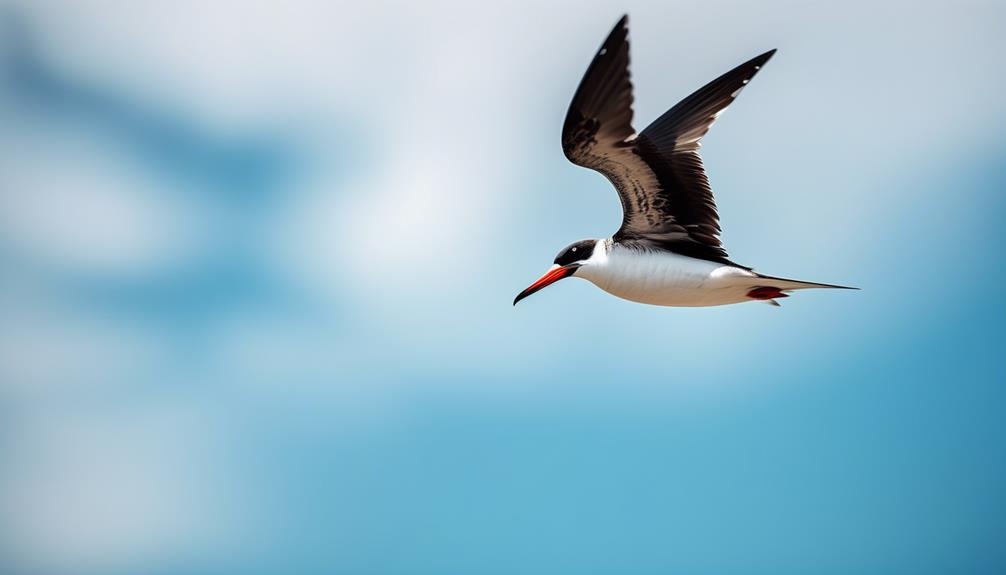
Have you ever wondered how the Black Skimmer got its name? Well, let me enlighten you. The Black Skimmer (Rynchops niger) is a unique bird with a distinctive appearance. Here are three interesting facts about their behavior patterns and habitat preferences:
- Behavior patterns:
- Skimming: Black Skimmers are known for their unique feeding technique called skimming. They fly low over the water with their lower bill submerged, snapping it shut when they come into contact with prey. This behavior allows them to catch fish, shrimp, and other small marine creatures.
- Nocturnal feeding: Unlike many other bird species, Black Skimmers are primarily active during the early morning and late evening hours. They've adapted to feed at night when their prey is more abundant and competition from other birds is reduced.
- Colonial behavior: Black Skimmers are highly social birds and often nest in large colonies, sometimes consisting of hundreds or even thousands of individuals. This behavior offers them protection from predators and allows for efficient foraging.
- Habitat preferences:
- Coastal areas: Black Skimmers are found along the coastlines of Florida and other southeastern states. They prefer sandy beaches, mudflats, and shallow coastal waters, where they can find suitable nesting sites and abundant food.
- Barrier islands: These birds are particularly fond of nesting on barrier islands. These narrow strips of land provide the ideal nesting habitat, with sandy or shell-covered beaches and minimal human disturbance.
- Estuaries and lagoons: Black Skimmers also inhabit estuaries, lagoons, and salt marshes. These habitats offer a diverse range of prey items and nesting opportunities, making them attractive to these birds.
Snowy Egret
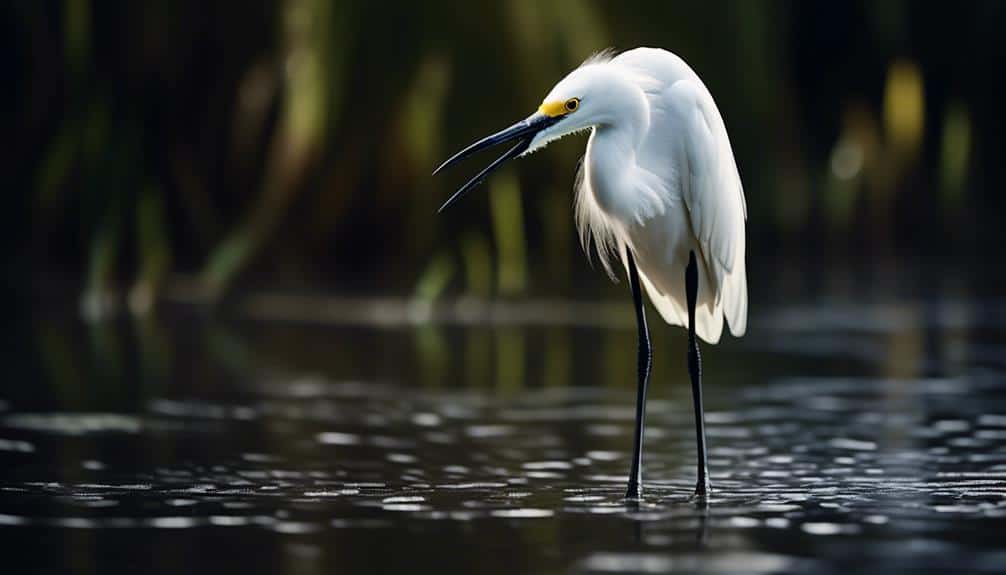
Snowy Egrets (Egretta thula) can be commonly observed in the coastal regions of Florida. These elegant birds are known for their striking white plumage, which contrasts beautifully with their black bills and legs. Snowy Egrets are highly adaptable and can be found in a variety of habitats, including marshes, estuaries, and wetlands. They've a preference for shallow water areas, where they can easily wade and forage for food.
Snowy Egrets exhibit interesting behavioral patterns. One of their most distinctive behaviors is their hunting technique known as 'canopy feeding.' This involves the egret extending its wings to create a canopy, which attracts fish and other small aquatic prey. Once the prey is close enough, the egret swiftly strikes with its sharp bill to capture its meal. This behavior isn't only efficient but also visually stunning to observe.
When it comes to habitat preferences, Snowy Egrets are highly adaptable. While they primarily inhabit coastal areas, they can also be found in inland wetlands and even urban environments. They're known to nest in colonies, often alongside other waterbird species. Their nests are typically constructed in trees or shrubs near water, providing a safe place for their young to hatch and grow.
Pied-billed Grebe
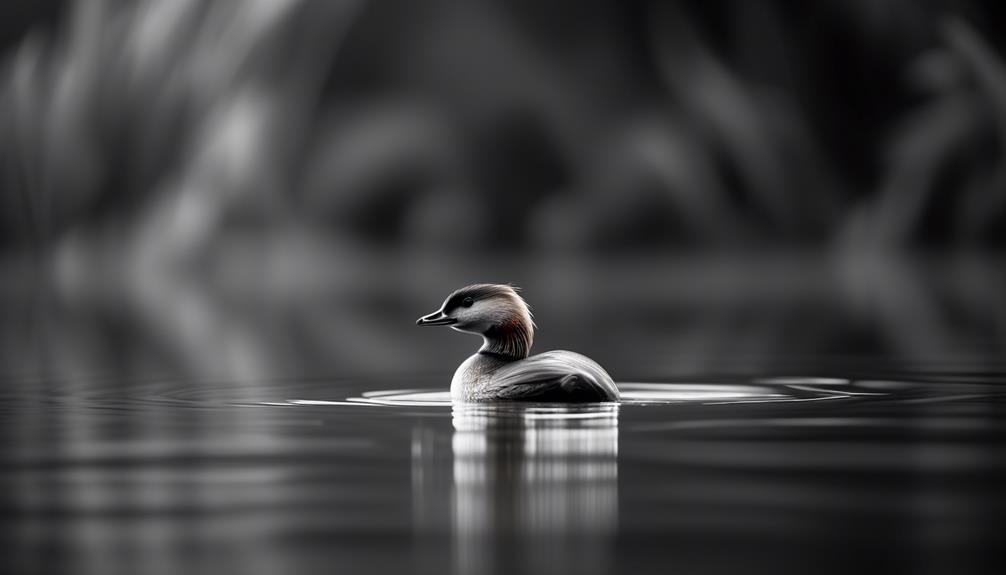
As I observe the diverse avian species in the coastal regions of Florida, my attention is drawn to the Pied-billed Grebe, a fascinating black and white bird that shares its habitat with the Snowy Egret.
The Pied-billed Grebe (Podilymbus podiceps) is a small waterbird known for its unique appearance and interesting behaviors. Here are three key aspects of their habitat preferences and breeding behavior:
- Habitat Preferences:
- Pied-billed Grebes are commonly found in freshwater habitats such as marshes, ponds, and lakes throughout Florida.
- They prefer areas with dense vegetation, as it provides cover and helps conceal their nests.
- These birds also inhabit coastal estuaries and brackish water bodies, showcasing their adaptability to different environments.
- Breeding Behavior:
- During the breeding season, Pied-billed Grebes engage in elaborate courtship displays. Males and females participate in synchronized head-shaking and diving rituals to establish pair bonds.
- They construct floating nests using plant material, typically concealed among emergent vegetation near the water's edge.
- The female lays a clutch of 4 to 7 eggs, which both parents take turns incubating. Once hatched, the chicks ride on their parents' backs for protection and warmth.
The Pied-billed Grebe's habitat preferences and breeding behavior exemplify their remarkable adaptation to aquatic environments. Their ability to thrive in various habitats makes them a captivating species to observe in the coastal regions of Florida.
Black-and-white Warbler

The Black-and-white Warbler (Mniotilta varia) is a small songbird known for its distinctive black and white plumage and unique foraging behavior. This species can be found in various habitats throughout North America, including forests, woodlands, and even urban parks.
The behavior patterns of the Black-and-white Warbler are quite fascinating. Unlike other warblers that primarily forage in the canopy, this species utilizes a behavior known as 'creeping' to search for insects. It moves along tree trunks and branches, similar to a nuthatch or a creeper, using its sharp bill to probe for prey hidden in the bark crevices. This foraging technique sets the Black-and-white Warbler apart from other warbler species and allows it to access food sources that aren't readily available to its counterparts.
In addition to its unique foraging behavior, the Black-and-white Warbler also exhibits interesting migration patterns. Like many other warblers, this species is a long-distance migrant, traveling thousands of miles each year between its breeding and wintering grounds. During the breeding season, Black-and-white Warblers can be found in the eastern parts of North America, including Florida, where they establish territories and raise their young.
As the summer comes to an end, these birds embark on a remarkable journey to their wintering grounds in Central and South America. They navigate through the Gulf of Mexico and the Caribbean, crossing vast expanses of open water, before reaching their final destinations. The Black-and-white Warbler's ability to undertake these long and arduous migrations is a testament to its remarkable adaptability and endurance.
Frequently Asked Questions
How Many American Oystercatchers Are There in Florida?
I estimate the population of American oystercatchers in Florida and discuss ongoing conservation efforts. The current number of oystercatchers in Florida is uncertain, but conservation efforts aim to protect and increase their numbers.
What Is the Average Wingspan of a Black Skimmer?
The average wingspan of a black skimmer is approximately 44-50 inches. The population trend of black skimmers in Florida has been stable, with conservation efforts helping to maintain their numbers.
Do Snowy Egrets Migrate to Other States During the Winter?
Yes, snowy egrets do migrate to other states during the winter. Understanding snowy egret migration patterns is crucial for assessing the impact of winter migration on their populations.
Are Pied-Billed Grebes Able to Fly Long Distances?
Yes, pied-billed grebes are capable of flying long distances. They have been observed migrating to different regions during the winter. Their migration patterns are influenced by factors such as food availability and weather conditions.
What Is the Habitat Preference of the Black-And-White Warbler in Florida?
In Florida, the black-and-white warbler population thrives in various habitats. Their preferred habitats include deciduous forests, mixed woodlands, and swampy areas. These birds exhibit unique behavioral patterns and nesting habits within these environments.
Conclusion
After observing the black and white birds of Florida, it's clear that these avian species possess unique characteristics that contribute to the diversity of the region's wildlife.
From the striking American Oystercatcher with its distinctive long orange bill, to the elegant Snowy Egret with its delicate plumes, each bird plays a vital role in the ecosystem.
The precise color patterns and behaviors of these black and white birds make them a captivating sight for both scientists and nature enthusiasts alike.

